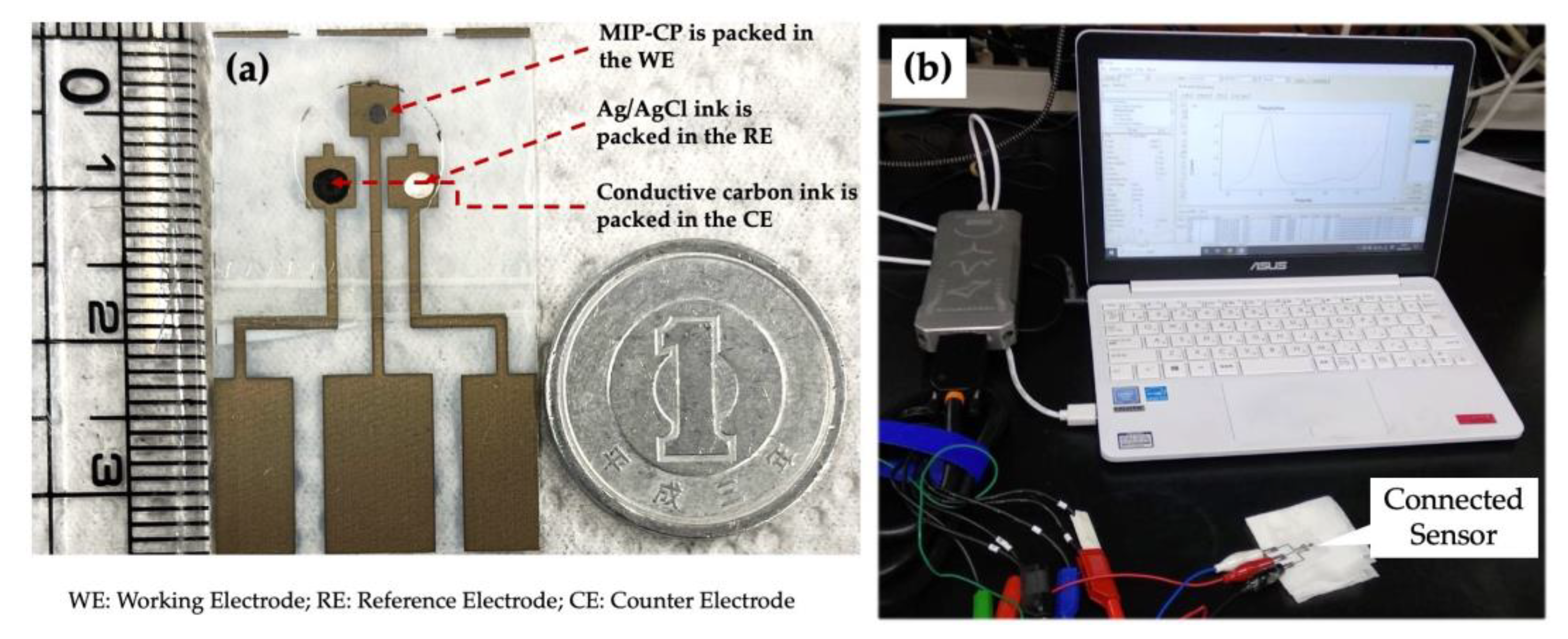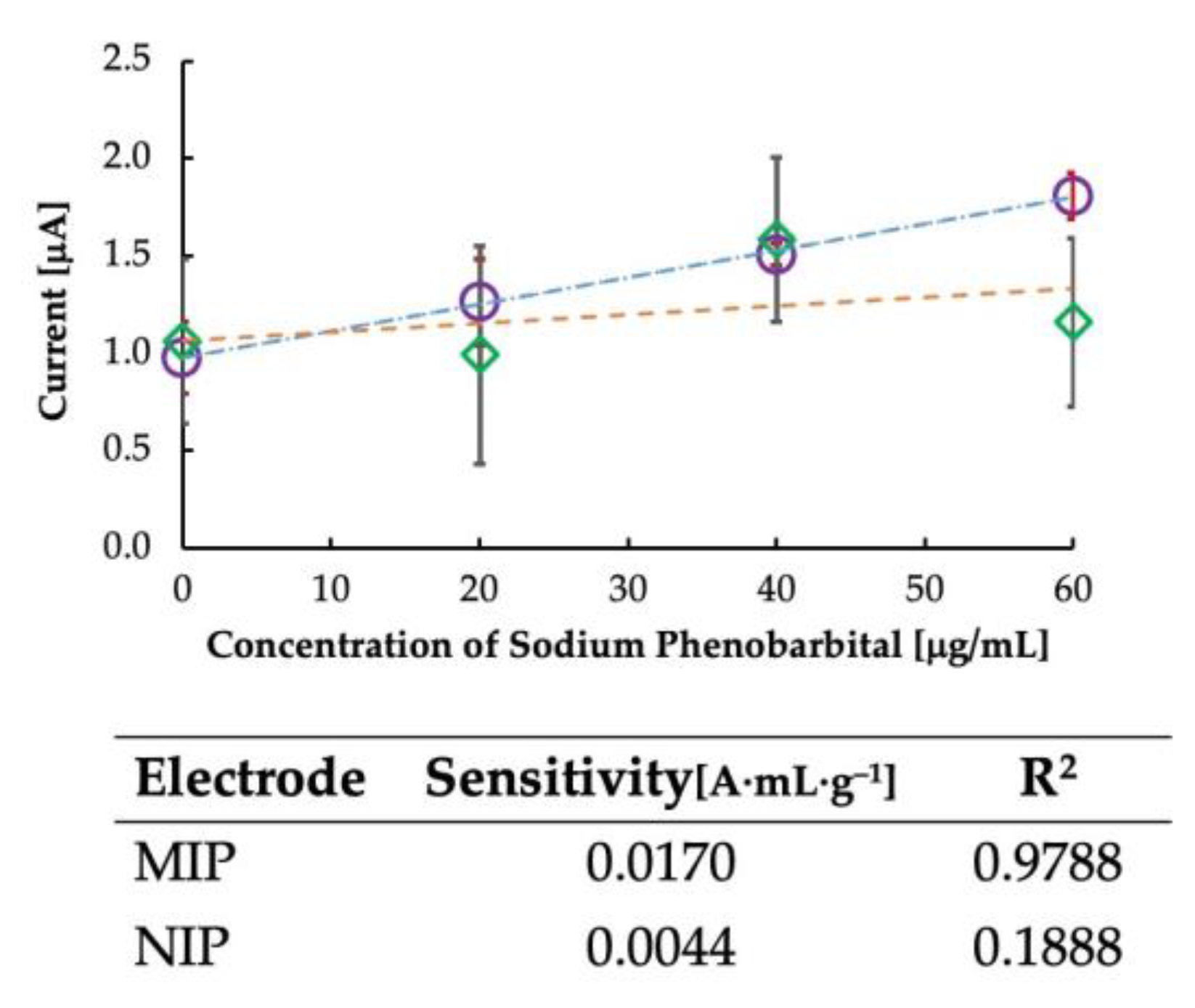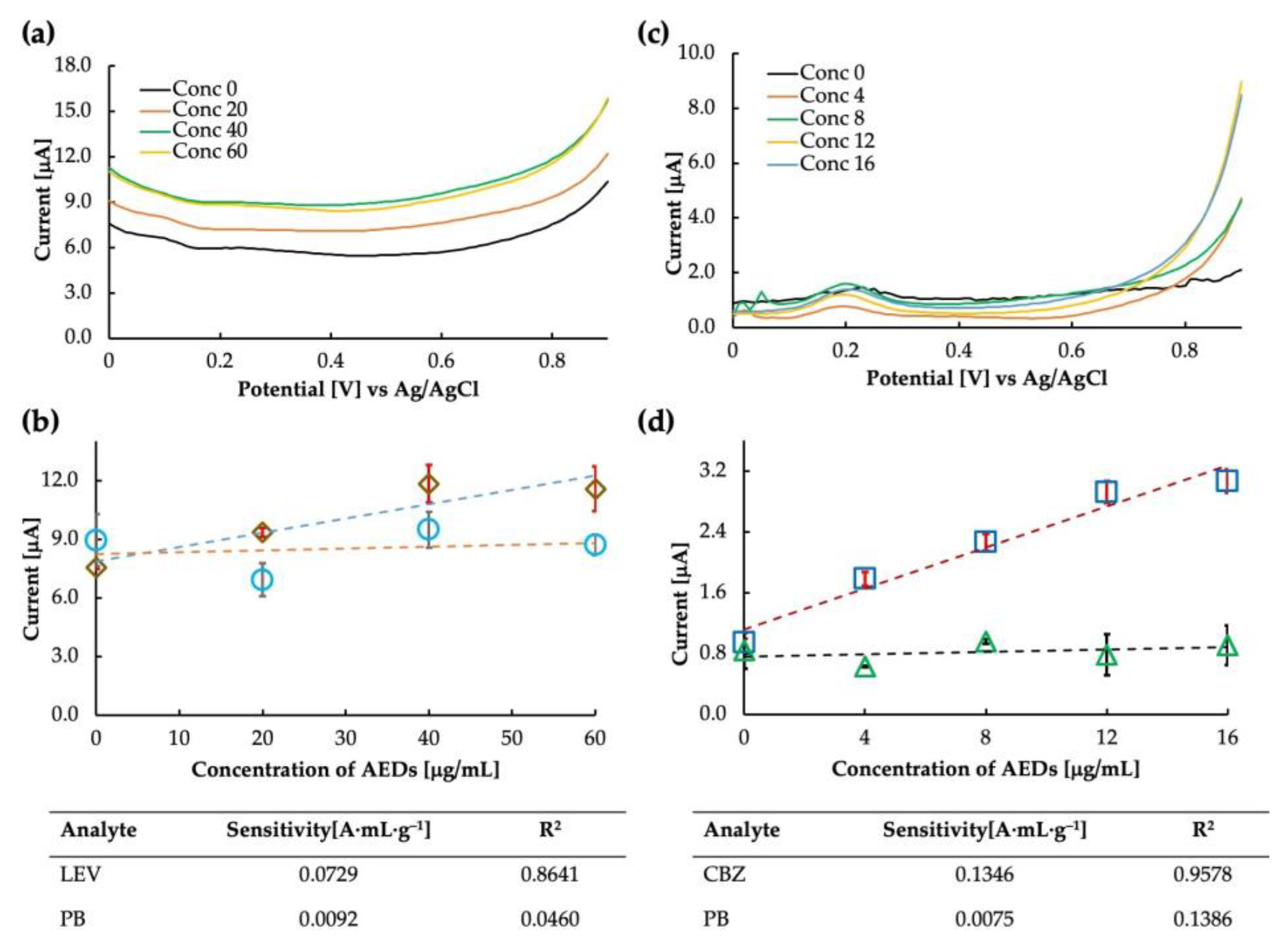Disposable Sensor Chips with Molecularly Imprinted Carbon Paste Electrodes for Monitoring Anti-Epileptic Drugs
Abstract
:1. Introduction
2. Materials and Methods
2.1. Materials and Instruments
2.2. Synthesis of Molecularly Imprinted Polymers
2.2.1. Phenobarbital MIP
2.2.2. Levetiracetam MIP
2.2.3. Carbamazepine MIP
2.3. The Disposable Chip Sensor
2.4. Measurement Parameters
3. Results and Discussions
3.1. Phenobarbital Sensor
3.2. Levetiracetam and Carbamazepine Sensors
| Target Drug | Electrode Material | Detection Method | Linear Range (mol·L−1) | Preparation Method | Reagent Required | Operation Time (min) | Plasma/Serum Separation | Refs. |
|---|---|---|---|---|---|---|---|---|
| PB | Nickel-modified glassy carbon | DPV | 1.4 × 10−7–1.3 × 10−4 | Thermal polymerization | Yes | >8 | NA | [34] |
| Glassy carbon | DPV | 1.0 × 10−8–1.8 × 10−4 | Electropolymerization | Yes | NA | NA | [35] | |
| Carbon paste | HPLC | 8.6 × 10−5–4.3 × 10−4 | - | Yes | NA | Yes | [36] | |
| Carbon paste | DPV | 0–3.0 × 10−4 | Photopolymerization | No | 2 | No | This work | |
| CBZ | Glassy carbon | CV, SWV | NA | Electropolymerization | Yes | NA | NA | [20] |
| Silver nanosphere on glassy carbon | CV, DPV | 1.0 × 10−9–5.0 × 10−6 | Electropolymerization | NA | NA | Yes | [37] | |
| Carbon paste | DPV | 0–5.0 × 10−5 | Photopolymerization | No | 2 | No | This work |
Author Contributions
Funding
Institutional Review Board Statement
Informed Consent Statement
Data Availability Statement
Conflicts of Interest
References
- Rho, J.M.; White, H.S. Brief History of Anti-seizure Drug Development. Epilepsia Open 2018, 3, 114–119. [Google Scholar] [CrossRef]
- Yu, Y.; Li, W.; Jiang, J. TRPC Channels as Emerging Targets for Seizure Disorders. Trends Pharmacol. Sci. 2022, 43, 787–798. [Google Scholar] [CrossRef] [PubMed]
- WHO. EPILEPSY a Public Health Imperative; International League Against Epilepsy: Flower Mound, TX, USA, 2019. [Google Scholar]
- Perucca, E. The Pharmacological Treatment of Epilepsy: Recent Advances and Future Perspectives. Acta Epileptol. 2021, 3, 22. [Google Scholar] [CrossRef]
- Badarny, S.; Badarny, Y.; Mihilia, F. Unusual Side Effects of Levetiracetam. BMJ Case Rep. 2021, 14, e242496. [Google Scholar] [CrossRef] [PubMed]
- Tahir, H.; Ayyaz, F.; Ekwegh, U. Visual and Auditory Hallucinations: An Uncommon Side Effect of Levetiracetam in an Elderly Patient. Cureus 2022, 14, e30668. [Google Scholar] [CrossRef]
- Hakami, T. Neuropharmacology of Antiseizure Drugs. Neuropsychopharmacol. Rep. 2021, 41, 336–351. [Google Scholar] [CrossRef]
- Patsalos, P.N.; Berry, D.J. Therapeutic Drug Monitoring of Antiepileptic Drugs by Use of Saliva. Ther. Drug Monit. 2013, 35, 4–29. [Google Scholar] [CrossRef] [Green Version]
- Min, K.L.; Ryu, J.Y.; Chang, M.J. Development and Clinical Applications of the Dried Blood Spot Method for Therapeutic Drug Monitoring of Anti-epileptic Drugs. Basic Clin. Pharmacol. Toxicol. 2019, 125, 215–236. [Google Scholar] [CrossRef] [Green Version]
- Patsalos, P.N.; Spencer, E.P.; Berry, D.J. Therapeutic Drug Monitoring of Antiepileptic Drugs in Epilepsy: A 2018 Update. Ther. Drug Monit. 2018, 40, 526–548. [Google Scholar] [CrossRef]
- Arfman, I.J.; Wammes-van der Heijden, E.A.; ter Horst, P.G.J.; Lambrechts, D.A.; Wegner, I.; Touw, D.J. Therapeutic Drug Monitoring of Antiepileptic Drugs in Women with Epilepsy Before, During, and After Pregnancy. Clin. Pharmacokinet. 2020, 59, 427–445. [Google Scholar] [CrossRef]
- Lahcen, A.A.; Amine, A. Recent Advances in Electrochemical Sensors Based on Molecularly Imprinted Polymers and Nanomaterials. Electroanalysis 2019, 31, 188–201. [Google Scholar] [CrossRef]
- Karimi-Maleh, H.; Karimi, F.; Alizadeh, M.; Sanati, A.L. Electrochemical Sensors, a Bright Future in the Fabrication of Portable Kits in Analytical Systems. Chem. Rec. 2020, 20, 682–692. [Google Scholar] [CrossRef]
- Brett, C.M.A.; Oliveira-Brett, A.M. Electrochemical Sensing in Solution—Origins, Applications and Future Perspectives. J. Solid State Electrochem. 2011, 15, 1487–1494. [Google Scholar] [CrossRef]
- Fekry, A.M.; Abdel-Gawad, S.A.; Azab, S.M.; Walcarius, A. A Sensitive Electrochemical Sensor for Moxifloxacin Hydrochloride Based on Nafion/Graphene Oxide/Zeolite Modified Carbon Paste Electrode. Electroanalysis 2021, 33, 964–974. [Google Scholar] [CrossRef]
- Prabhu, K.; Malode, S.J.; Shetti, N.P. Highly Sensitive Electrochemical Sensor for the Detection and Quantification of Linuron Based on Silica Gel Modified Carbon Paste Electrode. Environ. Technol. Innov. 2021, 23, 101687. [Google Scholar] [CrossRef]
- Liu, Y.; Li, T.; Ling, C.; Chen, Z.; Deng, Y.; He, N. Electrochemical Sensor for Cd2+ and Pb2+ Detection Based on Nano-Porous Pseudo Carbon Paste Electrode. Chin. Chem. Lett. 2019, 30, 2211–2215. [Google Scholar] [CrossRef]
- Mobed, A.; Shirafkan, M.; Charsouei, S.; Sadeghzadeh, J.; Ahmadalipour, A. Biosensors Technology for Anti-Epileptic Drugs. Clin. Chim. Acta 2022, 533, 175–182. [Google Scholar] [CrossRef]
- Wentland, L.; Downs, C.; Fu, E. Comparison of Signal Enhancement Strategies for Carbamazepine Detection in Undiluted Human Saliva Using an Electrochemical Sensor with Stencil-Printed Carbon Electrodes. Anal. Methods 2022, 14, 3103–3114. [Google Scholar] [CrossRef]
- Hammoud, A.; Chhin, D.; Nguyen, D.K.; Sawan, M. A New Molecular Imprinted PEDOT Glassy Carbon Electrode for Carbamazepine Detection. Biosens. Bioelectron. 2021, 180, 113089. [Google Scholar] [CrossRef]
- Aaryashree; Ohishi, T.; Yoshimi, Y. A Disposable Sensor Chip Using a Paste Electrode with Surface-Imprinted Graphite Particles for Rapid and Reagentless Monitoring of Theophylline. Molecules 2022, 27, 2456. [Google Scholar] [CrossRef]
- Yoshimi, Y.; Yagisawa, Y.; Yamaguchi, R.; Seki, M. Blood Heparin Sensor Made from a Paste Electrode of Graphite Particles Grafted with Molecularly Imprinted Polymer. Sens. Actuators B Chem. 2018, 259, 455–462. [Google Scholar] [CrossRef]
- Yola, M.L. Carbendazim Imprinted Electrochemical Sensor Based on CdMoO4/g-C3N4 Nanocomposite: Application to Fruit Juice Samples. Chemosphere 2022, 301, 134766. [Google Scholar] [CrossRef] [PubMed]
- Bölükbaşı, Ö.S.; Yola, B.B.; Boyacıoğlu, H.; Yola, M.L. A Novel Paraoxon Imprinted Electrochemical Sensor Based on MoS2NPs@MWCNTs and Its Application to Tap Water Samples. Food Chem. Toxicol. 2022, 163, 112994. [Google Scholar] [CrossRef]
- Hou, H.; Jin, Y.; Sheng, L.; Huang, Y.; Zhao, R. One-Step Synthesis of Well-Defined Molecularly Imprinted Nanospheres for the Class-Selective Recognition and Separation of β-Blockers in Human Serum. J. Chromatogr. A 2022, 1673, 463204. [Google Scholar] [CrossRef] [PubMed]
- Song, Z.; Li, J.; Lu, W.; Li, B.; Yang, G.; Bi, Y.; Arabi, M.; Wang, X.; Ma, J.; Chen, L. Molecularly Imprinted Polymers Based Materials and Their Applications in Chromatographic and Electrophoretic Separations. TrAC Trends Anal. Chem. 2022, 146, 116504. [Google Scholar] [CrossRef]
- Zhang, X.; An, D.; Zhang, R.; Huang, Y.; Liu, Z. Preparation of Carbon Nanotubes and Polyhedral Oligomeric-Reinforced Molecularly Imprinted Polymer Composites for Drug Delivery of Gallic Acid. Int. J. Pharm. 2022, 615, 121476. [Google Scholar] [CrossRef] [PubMed]
- Yuksel, N.; Tektas, S. Molecularly Imprinted Polymers: Preparation, Characterisation, and Application in Drug Delivery Systems. J. Microencapsul. 2022, 39, 176–196. [Google Scholar] [CrossRef]
- Li, X.; Wan, J.; Wang, Y.; Ding, S.; Sun, J. Improvement of Selective Catalytic Oxidation Capacity of Phthalates from Surface Molecular-Imprinted Catalysis Materials: Design, Mechanism, and Application. Chem. Eng. J. 2021, 413, 127406. [Google Scholar] [CrossRef]
- Li, X.; Wan, J.; Wang, Y.; Yan, Z.; Chi, H.; Ding, S. Mechanism of Accurate Recognition and Catalysis of Diethyl Phthalate (DEP) in Wastewater by Novel MIL100 Molecularly Imprinted Materials. Appl. Catal. B Environ. 2020, 266, 118591. [Google Scholar] [CrossRef]
- Cantarella, M.; Carroccio, S.C.; Dattilo, S.; Avolio, R.; Castaldo, R.; Puglisi, C.; Privitera, V. Molecularly Imprinted Polymer for Selective Adsorption of Diclofenac from Contaminated Water. Chem. Eng. J. 2019, 367, 180–188. [Google Scholar] [CrossRef]
- Dhanjai; Sinha, A.; Mugo, S.M.; Lu, X.; Chen, J. Molecular Imprinted Polymer-Based Biosensors for the Detection of Pharmaceutical Contaminants in the Environment. In Tools, Techniques and Protocols for Monitoring Environmental Contaminants; Elsevier: Amsterdam, The Netherlands, 2019; pp. 371–389. ISBN 9780128146798. [Google Scholar]
- Aaryashree; Takeda, Y.; Kanai, M.; Hatano, A.; Yoshimi, Y.; Kida, M. A “Single-Use” Ceramic-Based Electrochemical Sensor Chip Using Molecularly Imprinted Carbon Paste Electrode. Sensors 2020, 20, 5847. [Google Scholar] [CrossRef] [PubMed]
- Yu, H.C.; Huang, X.Y.; Lei, F.H.; Tan, X.C.; Wei, Y.C.; Li, H. Molecularly Imprinted Electrochemical Sensor Based on Nickel Nanoparticle-Modified Electrodes for Phenobarbital Determination. Electrochim. Acta 2014, 141, 45–50. [Google Scholar] [CrossRef]
- Yu, H.C.; Huang, X.Y.; Li, H.; Lei, F.H.; Tan, X.C.; Wei, Y.C.; Wu, H.Y. Preparation and Electrochemical Properties of Phenobarbital Molecularly Imprinted Polymer Sensor Based on a CuO Nanoparticle-Modified Glassy Carbon Electrode. Acta Physico-Chim. Sin. 2014, 30, 2085–2091. [Google Scholar] [CrossRef]
- Rahimi, M.; Bahar, S. Preparation of a New Solid-Phase Microextraction Fiber Based on Molecularly Imprinted Polymers for Monitoring of Phenobarbital in Urine Samples. J. Chromatogr. Sci. 2022, 61, 87–95. [Google Scholar] [CrossRef]
- Chen, C.; Wang, Y.; Ding, S.; Hong, C.; Wang, Z. A Novel Sensitive and Selective Electrochemical Sensor Based on Integration of Molecularly Imprinted with Hollow Silver Nanospheres for Determination of Carbamazepine. Microchem. J. 2019, 147, 191–197. [Google Scholar] [CrossRef]








| Matrix | Sensitivity [A·mL·g−1] | R2 |
|---|---|---|
| Buffer saline | 0.0170 | 0.9788 |
| Bovine whole blood | 0.0106 | 0.9560 |
| Bovine plasma | 0.0155 | 0.9826 |
Disclaimer/Publisher’s Note: The statements, opinions and data contained in all publications are solely those of the individual author(s) and contributor(s) and not of MDPI and/or the editor(s). MDPI and/or the editor(s) disclaim responsibility for any injury to people or property resulting from any ideas, methods, instructions or products referred to in the content. |
© 2023 by the authors. Licensee MDPI, Basel, Switzerland. This article is an open access article distributed under the terms and conditions of the Creative Commons Attribution (CC BY) license (https://creativecommons.org/licenses/by/4.0/).
Share and Cite
Aaryashree; Choudhary, A.K.; Yoshimi, Y. Disposable Sensor Chips with Molecularly Imprinted Carbon Paste Electrodes for Monitoring Anti-Epileptic Drugs. Sensors 2023, 23, 3271. https://doi.org/10.3390/s23063271
Aaryashree, Choudhary AK, Yoshimi Y. Disposable Sensor Chips with Molecularly Imprinted Carbon Paste Electrodes for Monitoring Anti-Epileptic Drugs. Sensors. 2023; 23(6):3271. https://doi.org/10.3390/s23063271
Chicago/Turabian StyleAaryashree, Ashish Kumar Choudhary, and Yasuo Yoshimi. 2023. "Disposable Sensor Chips with Molecularly Imprinted Carbon Paste Electrodes for Monitoring Anti-Epileptic Drugs" Sensors 23, no. 6: 3271. https://doi.org/10.3390/s23063271
APA StyleAaryashree, Choudhary, A. K., & Yoshimi, Y. (2023). Disposable Sensor Chips with Molecularly Imprinted Carbon Paste Electrodes for Monitoring Anti-Epileptic Drugs. Sensors, 23(6), 3271. https://doi.org/10.3390/s23063271






